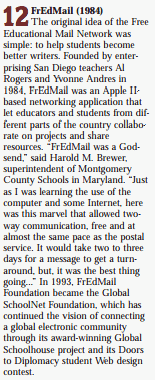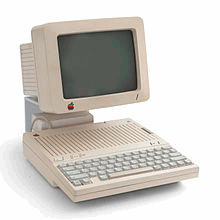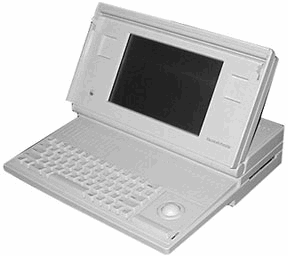A few weeks ago, Dean Shareski wrote a blog post (Great Moments in EdTech History), where he said,
I wanted to look back at my personal journey into educational technology and share a few instances of “aha moments” that I think many can relate to.
I so agreed with the items on his list – except for the coffee one – that I thought I would write my own. It’s not intended to be an improvement, and I suspect that many folks will not “relate” so well with some of my moments – ’cause you’re just not old enough, sonny.
My First Experience with a Personal Computer and BASIC
It was a Radio Shack Model I and this was when the hottest PCs on the planet were made by Radio Shack. The “aha” for me was when I realized that this was a machine that you operated by communicating with it. You typed in instructions and it followed. It even gave you instructions on what keys to press to do what you wanted, and you could change the functions of the keys by changing the instructions. In the way that only a few technologies in our past had, this was going to change everything.
I had to learn to program, because when the central office purchased the first set of computers for my school (Radio Shack Model IIIs – 16 kilobytes of memory), they didn’t know that you had to purchase software. So I learned to write BASIC code, so my students would have something to do on those computer – and that changed my life.
My First Apple IIe
The district I became director of tech in had also used Radio Shack TRS-80 computers. But times were changing, and we wanted to step up to the modern, sleeker and more state-of-the-art Apple IIes. They came with a 5 1/4 inch floppy disk that provided a tutorial for operating the machine. Booting it up I was presented with a light green pixelated outline drawing of an Apple computer. The outline of a floppy disk animated into view and the door of the external disk drive appeared to open. The disk slid into the drive and the operating light of the drive came on —– and it was red. Shudders went through my body and the earth’s crust seemed to shake under my feet. A color other than green. WOW! Anything was possible!
My First Modem
This was actually not such a stupendous moment since it took about three months to get my Apple IIc to communicate with the Hayes 300 baud modem, for which the district had paid $500. But when it finally worked, computers communicating over a distance — well that was cool. ..and the 300 baud was not a disappointment since it’s pretty much faster than I can read.
A user’s group of school districts in my area (Micro 5) set up a bulletin board system (BBS) so that we could support each other through our computers.
Al Rogers and FrEdMail

This was perhaps one of the greatest pivot points in my career. I knew of Al Rogers (see left) from his FrEdWriter software, a free word processor for Apple IIs. Al had developed a (BBS) whereby a district had its own bulletin board computer (Apple IIe with a 10 MB hard drive) that other modem-equipped school computers could dial into. Teachers and students could post messages (and other writings) to the BBS. In the middle of the night, the district bulletin boards (called nodes) would dial each other passing messages back and forth that were addressed to readers outside the local district. So I could write a message for a teacher in Australia, and over the night, it would be passed from node to node appear in the recipient’s mailbox the next morning.
 |
|
From “25 That Made their Mark” (2005) 1
|
A few weeks later our state Department of Public Instruction (DPI) called me asking if I would be willing to pilot a project for a FrEdMail network in our state, with seven other districts. We were called sysops (system operators), and it was the coolest thing ever. We did projects called HistoryLink, WeatherLink and it’s when Global Grocery List started. I joined DPI three years later and sysop’ed the state network, among other things.
My First Presentation with a Mac
The Macintosh, with its mouse, graphical interface and 3 1/2″ disk, was another game changer. But what I remember most about my first Mac production, a presentation for Micro-5 was that....I shadowed everything!
Telnet, FTP, IRC, Gopher
One of the other consultants at DPI had been approached by a university person offering an INTERNET login through his university. She offered it to me. I’d been able to email in and out of THE INTERNET for some time using FrEdMail. But I had not been able to actually connect. Logging in with TelNet, FTP gave me access mountains of text files located on about a hundred computers around the world. Then Gopher came, which provided a much more usable way of getting to files. Gopher was a world of interlocking menus, starting with a master menu at the University of Minnesota (go you gophers). Selecting options took you to other menus on other host computers until you ended up with the file you needed. Gopher meant that we no longer needed those secret incantations (ftp open 42.32.222.4, cd 97/files/, get listofearthquakes.txt) to navigate the Internet. The ideas you were looking for became your navigation.
The World Wide Web
WWW had been around for a while before it really caught on. It wasn’t until Marc Andreessen (as an undergraduate student at the University of Illinois – Urbana-Champlaign) created Mosaic that people started to see the potential. With the Mosaic software, you could mouse around, click on words to link to other documents, and see pictures. Now the information itself became the steering wheel for content navigation. It was also cool that the default background color for web pages was metal gray.
HTML
The best thing about the World Wide Web and Mosaic was that you could show it to people and they didn’t yawn. Non-techies began to get it, that there was something potentially mainstream about this Internet thing. One afternoon (1993), while at DPI, I’d reached a lull in my work and downloaded a tutorial for coding HTML. I was aghast at how easy it was and by the end of there afternoon, I’d already written a web page with hyperlinks and images. Over the next couple of months I covertly created a mock-up web site for the department and showed it to the assistant superintendent for instruction. Even though he was not a techie and had his secretary print out his e-mails. he instantly realized the potential and assigned me to create a web site for the agency. It was the first state department of education web site and was launched in 1994 – on the same day that our newly elected (conservative) legislature demanded a 50% reduction in staff for DPI. I volunteered for layoff a few months later in exchange for a severance package and have not be traditionally employed since.
Meeting an Inventor
In 1997, I was doing some consulting and training for Advanced Network and Services and their ThinkQuest project. Part of my work was staffing booths at conferences and giving away ThinkQuest CDs. Late one afternoon I was working a booth at a European SchoolNet conference in Dublin and a man walked by, in something of a hurry. He glanced over, stopped and asked, “What is ThinkQuest?” My partner, a TQ representative from The Netherlands, and I explained it to him and he said, I’ll try to get back here after my talk,” and hurried off. My partner turned to me and asked, “Do you know who that was?” I shook my head (which rattled a bit). “That was Robert Caillaiu, one of the inventors of the World Wide Web.”
I was impressed, though I’d never heard of Caillaiu before. About an hour later, he came back, fast talking, energetic, possibly a little A.D.H.D., and he asked a lot of questions, and finally asked how I wrote my HTML. I told him that I’d created a Hypercard stack for my editor, and he said that he had done the same. He glanced over and asked if that was my Mac laptop, and nodded, “Yes!”
He pulled out a disk, slid it into the slot of his laptop, and copied his Hypercard HTML editor and handed me the disk, which I copied to my Mac. 🙂
Alas, my hard drive crashed a week and a half after I returned home and my dreams of framing Caillaiu’s code and mounting it on my office walls were dashed.
PHP and MySQL
Your first inclination is to skip over this one, but these two acronyms (of which I’m not going to bore you with their complete spelling) elevated me to full wizard status. HTML enables us to publish information on the web. MySQL, however, collects, stores, and selectively delivers information, and PHP causes that information to behave in useful and interesting ways. Sounds pretty tedious, but without these two, we would probably never had seen a Web 2.0.
For me, out of these two acronyms came Citation Machine, PiNet (no longer supported), Hitchhikr (defunct), Education Podcast Network, Class Blogmeister and many others.
Blogs, Wikis and Twitter
Web 2.0 elevated us all to new levels of experience and accomplishment, and it hasn’t slowed down yet. But what probably impacted me the most was RSS. I won’t go into detail, except to say that while PHP & MySQL enabled us to do interesting things with information, RSS empowers us to do interesting things with conversations.
Mobile Computing and Apps
Mobile computing has been around forever. I own an Apple Newton, which was the coolest things on land and sea in 1993. But Palm was king for years, because it did about three things really well. Then the iPhone and the iPod Touch came along with their apps and a burgeoning community of talented and creative app builders – and then the iPad – and we had devices we could carry around with us that could do or become just about anything we could imagine. These are truly personal machines that, by nature, become more than they were when they launched – and not because of the original designers, but because of people like us with useful (and no limit of useless) ideas and the skills to remold the machines to make them happen.
What’s next? Well isn’t that what we’re about in education. But it seems that in this time of incredible creativity, we seem defenseless against powerful interests who want to standardize education, for the production graduates who can be monetized. Will we serve the beast or do we nurture our children and their uniquely boundless capacity to continually and freely invent futures that serve us all.
1 McLester, Susan. “25 That Made Their Mark.” Technology & Learning Magazine. Nov 2005: 5-15. Web. 22 May. 2012. <http://goo.gl/cxJFt>.






